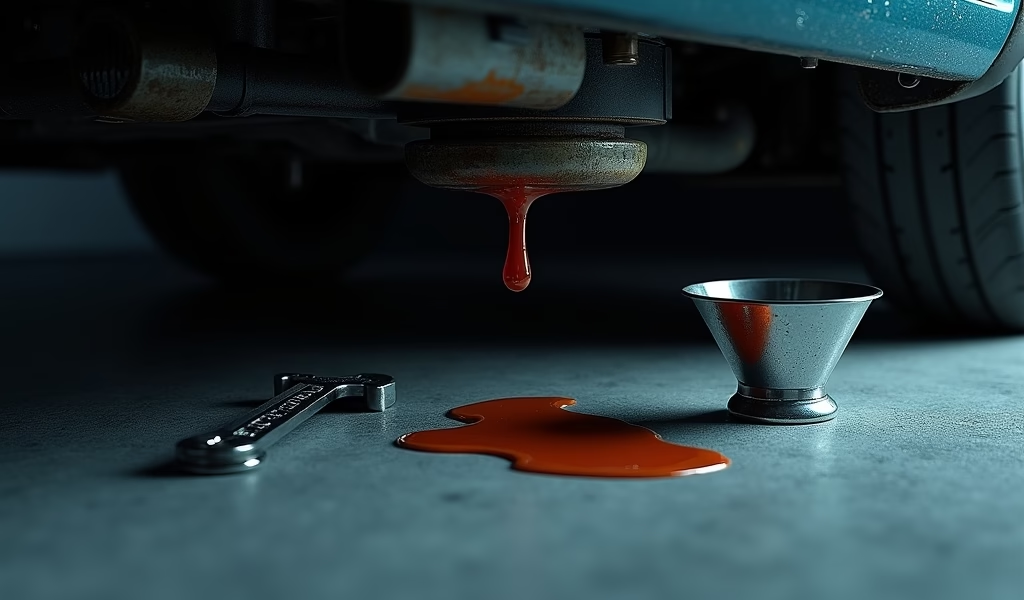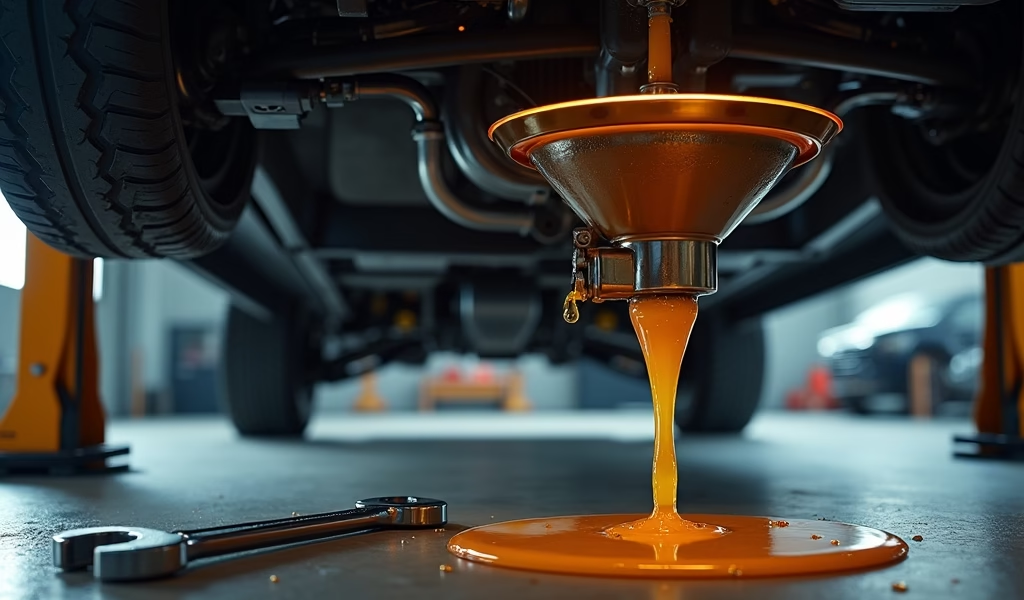Overview
This article provides four DIY techniques for replacing viscous coupling fluid in all-wheel drive vehicles: the basic drain and fill method, precision syringe approach, emergency fluid alternatives, and professional-grade vacuum filling. It emphasizes that proper maintenance can save hundreds in repair costs while extending AWD system life, with specific recommendations for creating personalized maintenance schedules based on driving conditions and vehicle usage patterns.
Table of Contents
- Understanding Viscous Coupling: The Heart of Your AWD System
- Signs Your Viscous Coupling Fluid Needs Replacement
- Hack #1: The Drain and Fill Shortcut
- Hack #2: The Precision Syringe Method
- Hack #3: Emergency Fluid Alternatives
- Hack #4: The Professional-Grade Vacuum Fill Technique
- Creating Your Perfect Maintenance Schedule
- Conclusion: Your AWD’s Second Chance at Life
- Frequently Asked Questions
Understanding Viscous Coupling: The Heart of Your AWD System
Picture this: your all-wheel-drive vehicle gracefully navigating a rain-slicked corner while lesser cars struggle for grip. That magical moment? It’s your viscous coupling working its silent magic—like a maestro conducting a symphony of power distribution between your wheels.
As a mechanic who’s had my hands deep in countless AWD systems, I can tell you this unsung hero deserves more attention than it gets. The viscous coupling unit serves as the peacekeeper between your axles, using specialized silicone fluid to transfer torque when traction differences occur. When one wheel slips, this fluid’s molecular structure instantly responds, shifting power to wheels with better grip.
But here’s the rub—this specialized silicone fluid doesn’t last forever. Over time, it breaks down from heat cycles and mechanical shear, becoming less effective at its critical job. Manufacturers typically recommend replacement every 30,000-60,000 miles, but I’ve seen too many drivers push well beyond these limits, often with expensive consequences.
Why pay the dealer $300-800 for this service when you can handle it yourself? With these tried-and-true hacks from my two decades in the shop, you’ll not only save a bundle but also develop a deeper connection with your vehicle’s inner workings. Think of it as giving your AWD system a refreshing drink after a marathon—something it desperately needs but rarely receives.
Signs Your Viscous Coupling Fluid Needs Replacement
Before we dive under the car, let’s talk symptoms. Your AWD system speaks a language of subtle (and sometimes not-so-subtle) cues when its viscous coupling fluid is crying for replacement.
Have you noticed that mysterious “clunk” when cornering or accelerating? That’s not your imagination—it’s your coupling’s desperate plea for fresh fluid. When the silicone fluid degrades, it loses its ability to transfer power smoothly, resulting in jerky engagement that reverberates through your drivetrain like thunder on a summer night.
Other warning signs include:
- Inconsistent power delivery between axles
- The AWD warning light illuminating intermittently
- Unusual vibrations at specific speeds
- Difficulty cornering that wasn’t present before
- Strange noises specifically during tight turns
I recently worked with Sarah from Denver whose Subaru Forester developed an odd binding sensation during tight parking maneuvers. The dealer quoted her $750 for a coupling service. Two hours in her driveway with fresh fluid, and the car drove like new—all for less than $100 in materials. The look on her face when she took that first smooth turn? Priceless.

Hack #1: The Drain and Fill Shortcut
This straightforward approach is perfect for weekend warriors with basic mechanical skills. Think of it as giving your AWD system a transfusion—out with the old, in with the new, without major surgery.
What you’ll need:
- Socket set with the appropriate sizes for your vehicle
- Torque wrench (precision matters here!)
- Clean drain pan
- Manufacturer-recommended viscous coupling fluid
- Fresh crush washers (if specified)
- Clean funnel with a narrow spout
- Shop towels for inevitable drips
- Jack and stands rated for your vehicle’s weight
Instead of removing the entire coupling unit (as some overpriced service manuals suggest), you can often access the drain and fill plugs directly. This approach slashes your service time from a full day to about an hour.
Step-by-step process:
- Warm up your vehicle with a 15-minute drive. Like honey flowing faster when warm, heated viscous coupling fluid drains more completely.
- Elevate your vehicle securely on jack stands. Your life is worth more than cutting corners on safety!
- Locate the viscous coupling unit (typically near the rear differential or center transfer case).
- Position your drain pan underneath—wider is better as this fluid sometimes has a mind of its own when draining.
- Remove the drain plug slowly, being careful not to strip the threads. These are often aluminum and softer than you might expect.
- Allow all fluid to empty completely—patience is a virtue that will reward you with better performance. This typically takes 15-20 minutes.
- Replace the drain plug with a new crush washer if required. Hand-tighten first, then torque to specification.
- Remove the fill plug and slowly add new fluid until it begins to overflow slightly. This indicates the system is full.
- Replace the fill plug and torque precisely to manufacturer specs.
Watch out for: Cross-threading is the mortal enemy of this operation. Always start threading by hand, and if you feel any resistance, back out and try again. As my old mentor used to say, “Force it and buy it”—meaning forced threads lead to expensive replacement parts.
I once had a customer—let’s call him Mike—who attempted this service but rushed the plug reinstallation. The resulting stripped thread turned his $80 DIY job into a $600 repair. Don’t be like Mike; patience pays dividends in this process.
Hack #2: The Precision Syringe Method
When absolute precision meets mechanical elegance, the syringe method stands tall as my personal favorite technique. This approach allows for exact measurement of fluid replaced—critical for optimal performance in systems where even 10ml too much or too little can affect handling characteristics.
Materials required:
- Large automotive syringe (60-100ml capacity)
- Clear, chemical-resistant tubing that fits snugly on the syringe
- Manufacturer-specified fluid
- Clean container for measuring old fluid
- Disposable gloves
- Cleaning supplies for inevitable drips
The syringe method shines brightest on vehicles with limited access or those requiring precise fluid volumes. It’s like performing keyhole surgery instead of open-heart—minimal intrusion with maximum results.
The procedure:
- Secure your vehicle safely on level ground. Unlike the drain method, this technique doesn’t always require elevation.
- Locate the fill port of your viscous coupling.
- Attach the tube to your syringe and insert it into the port, ensuring it reaches deep into the coupling.
- Slowly extract the old fluid, counting exactly how much you remove. This is your benchmark for replacement.
- Examine the old fluid—healthy coupling fluid should be clear with a slight amber tint. If it’s dark or has metallic particles, your coupling may need more than just fresh fluid.
- Prepare your new fluid in the clean syringe, matching the exact amount removed.
- Before injection, purge air bubbles by pointing the syringe tip upward and gently tapping while slowly pushing until a small amount of fluid appears at the tip.
- Slowly inject the fresh fluid into the coupling at a steady pace.
Those pesky air bubbles are the nemesis of a properly functioning viscous coupling. They create pockets where fluid should be, leading to inconsistent performance and accelerated wear. Take your time with the purging step—your coupling will thank you with miles of trouble-free service.
I’ve used this technique on everything from delicate Audi Quattro systems to rugged Mitsubishi Super Select setups. The precise fluid exchange results in noticeably smoother power transitions between axles, especially noticeable during partial traction scenarios like wet corners or snowy conditions.
Hack #3: Emergency Fluid Alternatives
We’ve all been there—it’s Sunday afternoon, your project is 90% complete, and suddenly you realize you’re short on the specific fluid needed. The parts stores are closed, you’re miles from anywhere, and your half-disassembled vehicle sits accusingly in the garage. What’s a resourceful DIYer to do?
While I always advocate using manufacturer-specified fluids for optimal performance and longevity, real life sometimes throws curveballs that require creative solutions. In a pinch, certain alternative fluids can serve as temporary stand-ins until you can complete the job properly.
Compatible temporary substitutes:
- Certain synthetic automatic transmission fluids with similar viscosity ratings (check compatibility for your specific model)
- High-quality silicone-based lubricants designed for similar applications
- In some older vehicles, specific differential oils (research thoroughly first!)
I once helped a customer stranded in Wyoming’s backcountry with a leaking viscous coupling. With nothing but a quality synthetic ATF in his emergency kit, we were able to create a temporary fix that got his family safely back to civilization—a 120-mile journey that would have otherwise required an expensive tow.
When alternatives are absolutely NOT an option:
- High-performance or newer vehicles with specialized requirements
- When the manufacturer explicitly warns against substitutions (some Honda and Mitsubishi systems fall here)
- If your vehicle is still under warranty (the savings aren’t worth voiding thousands in coverage)
Remember: Alternative fluids should be considered emergency solutions only—the automotive equivalent of a spare tire. They’ll get you home, but you’ll want to replace with the proper fluid as soon as possible, preferably within 100-200 miles of driving.
I’ve seen the expensive consequences of “permanent temporary fixes” too many times. One customer’s “good enough” ATF substitute in his viscous coupling saved him $40 in specialized fluid but cost him $1,200 in coupling replacement six months later. The silicone additives missing from standard transmission fluid had allowed excessive wear in the coupling plates.

Hack #4: The Professional-Grade Vacuum Fill Technique
For those seeking the gold standard in DIY coupling maintenance, the vacuum fill method stands head and shoulders above the rest. This technique, borrowed from professional shops, ensures complete fluid exchange and eliminates microscopic air pockets that can cause coupling damage.
Think of it as the difference between watering a plant by pouring from above versus allowing it to draw water up through its roots—the latter ensures complete saturation with no dry spots.
Creating a DIY vacuum system:
- Hand vacuum pump with gauge (available at most auto parts stores for $30-50)
- Appropriate adapters to connect to your coupling’s fill port
- Catch container for old fluid
- Fluid reservoir for the new fluid
- Clear tubing rated for automotive fluids
- Y-connector to switch between extraction and filling
The magic of this method lies in physics—creating negative pressure within the coupling that actively pulls old fluid out and draws new fluid in without introducing air. The result is a perfectly filled coupling with optimal performance characteristics that rival factory-fresh condition.
Execution:
- Connect your vacuum pump to the fill port using appropriate adapters.
- Create negative pressure within the coupling (typically 15-20 inHg).
- Position the extraction tube in your catch container.
- Open the valve to allow old fluid to be extracted completely.
- Once extraction is complete, close the valve to maintain vacuum.
- Switch the vacuum line to your new fluid container using the Y-connector.
- Open the valve again, letting vacuum pull fresh fluid into the coupling until full.
- Monitor the fluid flow—when it stops naturally, the coupling is properly filled.
The vacuum method excels at reaching hidden pockets in complex coupling designs that other methods might miss. I’ve seen dramatic performance improvements in vehicles that had previously received “conventional” fluid services but continued to exhibit symptoms.
Tim’s 2010 Volvo XC70 is a perfect example—after two standard drain-and-fills elsewhere, he still experienced binding during tight turns. Our vacuum service extracted nearly 15% more old fluid than previous attempts, and the car has performed flawlessly for 40,000 miles since.
If your vacuum seems weak or fluid flow stops unexpectedly, check all connections for leaks. A small air leak can significantly reduce effectiveness. Apply a light coating of petroleum jelly to connection points if you suspect leakage—it works wonders as a temporary seal during the procedure.
Creating Your Perfect Maintenance Schedule
Just as no two drivers are identical, neither are their maintenance needs. Your viscous coupling fluid replacement schedule should be as personalized as your favorite playlist—tailored specifically to your driving style, environment, and vehicle.
Like a fine wine, your driving habits and environment dramatically affect how quickly your coupling fluid degrades. The manufacturer’s recommendation is merely a starting point—your actual needs may vary significantly based on real-world conditions.
Extending fluid life:
- Avoid excessive “spirited” driving that creates heat in the AWD system
- Allow your vehicle to warm up properly in cold weather before demanding full AWD performance
- Use only manufacturer-recommended fluids with the proper specifications
- Consider an auxiliary cooling system if you frequently tow or drive in mountainous regions
Environmental factors play a huge role in fluid longevity. In Phoenix, where summer temperatures flirt with 115°F, the fluid change frequency should be nearly doubled compared to temperate climates. The extreme heat accelerates fluid breakdown, turning a 50,000-mile interval into a 25,000-mile necessity.
Similarly, those braving Minnesota winters face different challenges—fluid thickening that can stress coupling components during cold starts. The thermal cycling between extreme cold and operating temperature creates unique stress patterns that can shorten fluid life substantially.
Create your personalized schedule:
- Start with the manufacturer’s recommended interval as your baseline
- Reduce by 25-30% if you live in extreme climates (consistently above 100°F or below 10°F)
- Reduce by 20-25% if your driving style includes frequent spirited acceleration or performance driving
- Reduce by 15-20% if you regularly tow or carry heavy loads
- Consider reducing by 10-15% if you frequently drive on unpaved roads or in dusty conditions
I advise my clients to examine the fluid condition at each differential service, even if replacement isn’t scheduled. This visual inspection provides valuable feedback about your system’s health and can help refine your personal maintenance schedule.
Jason, who frequently tows his boat through the Rocky Mountains, discovered his Nissan Pathfinder needed coupling fluid service every 22,000 miles despite the factory 45,000-mile recommendation. This proactive approach has kept his AWD system performing flawlessly for over 200,000 miles—proof that personalized maintenance trumps one-size-fits-all recommendations.
Conclusion: Your AWD’s Second Chance at Life
Caring for your viscous coupling isn’t just about avoiding repair bills—it’s about preserving that confident, sure-footed feeling that made you choose an AWD vehicle in the first place. Like giving a marathon runner fresh shoes, fresh coupling fluid restores your vehicle’s ability to perform as the engineers intended.
The hacks we’ve explored today transform a potentially expensive dealer service into an approachable DIY project:
- The Drain and Fill Shortcut: Perfect for beginners seeking the fastest route to fresh fluid
- The Precision Syringe Method: Ideal for those demanding exact fluid replacement volumes
- Emergency Fluid Alternatives: Your get-home solution when the unexpected occurs
- The Vacuum Fill Technique: The gold standard for complete service rivaling professional results
Each approach has its place in your maintenance arsenal, depending on your comfort level, available tools, and specific vehicle needs. The key is taking action before your coupling fluid degrades beyond the point of simple replacement.
Remember—your AWD system is only as good as the fluid flowing through it. Give your viscous coupling the care it deserves, and it will reward you with thousands of miles of confident driving in conditions that leave lesser vehicles spinning their wheels.
The next time you effortlessly navigate that snow-covered road or rain-slicked corner, you’ll smile knowing your hands made it possible—not just your wallet. And isn’t that connection with your vehicle what driving is really all about?
Frequently Asked Questions
How often should viscous coupling fluid be replaced?
Most manufacturers recommend replacement every 30,000-60,000 miles, but this varies by vehicle make and model. Adjust this interval based on your driving conditions, climate, and usage patterns.
What happens if I don’t replace my viscous coupling fluid?
Degraded fluid leads to poor torque transfer, inconsistent AWD performance, and eventually coupling failure. The repair cost for a failed coupling unit typically runs $1,500-3,000, making preventive maintenance the economical choice.
Can I use any type of fluid in my viscous coupling?
No, always use the manufacturer-specified fluid for your specific model. Using incorrect fluid can cause rapid coupling degradation and potentially catastrophic failure.
How do I know if my viscous coupling is failing?
Watch for symptoms like binding during tight turns, clunking noises during acceleration or deceleration, and inconsistent power delivery between axles. AWD warning lights or strange vibrations are also common indicators.
Is viscous coupling fluid replacement a beginner-friendly DIY job?
The basic drain and fill method is accessible to most DIYers with basic mechanical knowledge and tools. More advanced techniques like vacuum filling require additional equipment but still remain within reach of a motivated home mechanic.

